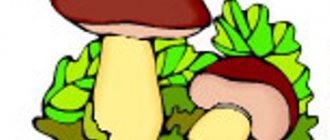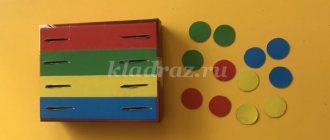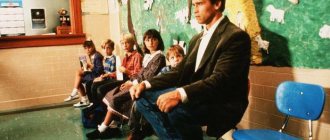The importance of theatrical games for children 1.5–3 years old
A preschooler learns about the world around him through the most interesting and accessible way of processing information - through play. In this sense, theatrical games turn out to be a very productive method of organizing educational activities, since they are based on improvisation and revitalization of objects with the help of speech, and also, which is especially important for non-speaking or poorly speaking children, facial expressions and gestures.
This is interesting. In the methodological literature, the concepts of “theatrical play” and “theatrical activity” are often considered synonymous.
In the first junior group, theatrical games help children develop speech
Goals and objectives of theatrical play in preschool educational institutions
In addition to the adaptation and socialization of children who have just entered kindergarten, theatrical activities make it possible to achieve a set of educational goals:
- develops speech (children learn to understand speech addressed to them by repeating the words of the characters after the teacher, kids pronounce, that is, develop a speech pattern, form their own speech image),
- enriches pupils with knowledge, skills and abilities from different areas (since theatricalization is a universal technique in all classes, children learn new information through play and work it out in practice),
- fosters independence (children learn to make decisions in the game),
- develops memory, thinking (mainly figurative, since the visual-figurative type of perception of the surrounding world is the most developed in preschoolers),
- gives physical activity, develops coordination of movements,
- fosters a sense of teamwork (the children of the first junior group, due to age characteristics, play not together, but side by side, but theatrical activities allow them to quickly move to the level of co-creation and cooperation).
Theatrical games in the first junior group help children learn cooperation
In order to realize the assigned tasks, when conducting theatrical games, the teacher solves the following tasks:
- enriches vocabulary (based on the age of the children, it is still mostly passive),
- activates the cognitive interest of his students through familiarity with dramaturgical characters that are understandable for this age (for example, to explain to kids the concept of “equally,” the teacher suggests staging a fairy tale about two bear cubs who could not share an apple themselves, but the fox who volunteered to help them ate it),
- develops fine motor skills (due to the interaction of children with small dolls, natural material that replaces “artists”),
- increases self-confidence (at this age, many children already begin to feel shy about public speaking, so it is very important to make theatrical games a habitual technique in their work so that children do not view the demonstration as something unusual, and therefore scary and embarrassing),
- reaction training (kids get used to starting and ending the game according to a conditioned signal),
- emotional and sensory development (children learn to convey and recognize the experiences of another person through facial expressions, gestures, intonation),
- developing the skill of coordinating one’s activities with what other children are doing (children of the first junior group have difficulty engaging in activities all at the same time, which is why theatrical games are so methodically valuable, allowing them to interest many students at once).
Theatrical games help to engage many kids at the same time
Principles of games
Theatrical games in the context of the educational process are based on the general patterns of development of children aged 1.5–3 years. Therefore, in order to create favorable conditions for practicing theatrical activities, it is important:
- diversify the topics (not only including fairy tales recommended by the program, but also plots of popular cartoons and poems),
- include elements of theatrical games in different classes (for example, as a reinforcement of the material covered or in open lessons),
- minimize stress factors (that is, with the help of theatrical activities, ensure a harmonious transition from one type of work to another, without a sudden switch from reading to physical exercise, for example),
- to liberate little performers (for this, many teachers hold “Open Days” together with mothers - holidays at which children demonstrate their performing abilities),
- create an objectively real situation of success for children (it is important that each participant in the theatrical game receives well-deserved praise).
Games should create a situation of success for each participating child.
Progress of the game.
Using a rhyme, a child is selected to play the role of king. The remaining child workers are divided into several groups (3 - 4)
and agree on what they will do and what work they will be hired for.
Then they approach the king in groups .
Workers. Hello King!
King. Hello!
Workers. Do you need workers?
King. What can you do?
Workers. Guess it!
Children, acting with imaginary objects, demonstrate various professions: cooking, washing clothes, sewing clothes, embroidering, watering plants, etc. The king must guess the profession of the workers. If he does it correctly, he will catch up with the fleeing children. The first child caught becomes king. Over time, the game can be complicated by introducing new characters (queen, minister, princess, etc.), as well as inventing the characters of the characters (king - greedy, cheerful, evil; queen - kind, grumpy, frivolous).
Card No. 12 “BIRTHDAY”
Target. Develop skills in working with imaginary objects,
cultivate goodwill and contact in relationships with peers.
Progress of the game.
The object is placed on a chair in the center of the circle or passed around the circle from one child to another. Everyone must act with the object in their own way, justifying its new purpose, so that the essence of the transformation is clear. Options for the transformation of different objects:
a) pencil or stick - key, screwdriver, fork, spoon, syringe, thermometer, toothbrush, paint brush, pipe, comb, etc.;
b) a small ball - an apple, a shell, a snowball, a potato , a stone, a hedgehog, a bun, a chicken, etc.;
c) notebook - mirror, flashlight, soap, chocolate, shoe brush, game.
You can transform a chair or a wooden cube, then children must justify the conventional name of the object.
For example, a large wooden cube can be turned into a royal throne, flowerbed, monument, bonfire, etc.
Card No. 11 “KING (version of the folk game)
»
Target. Develop actions with imaginary objects, the ability to act in concert.
Progress of the game:
Teacher in front of the children sitting at the table. There is a house on the table with a little bear looking out of the window.
Teacher. Oh, whose face appeared in the window?
The children answer that it is a bear. The teacher takes him out from behind the house and draws the children’s attention to how the bear purrs when greeting them. Then he asks the children to purr in the same way.
Suddenly the bear hides behind the house.
Teacher: Teddy bear, playful Teddy bear!
Where are you? Where are you? Answer me!
Teddy bear, Naughty Teddy Bear!
Where are you? Where are you? Show yourself!
The bear's head appears in the window again. He shakes his head and purrs. Children imitate him. The display game is repeated at the request of the children. Various characters familiar to children can hide. And every time the teacher encourages the children to imitate the “voices”
these characters.
Card No. 6 “We won’t tell you where we were, but we’ll show you what we did.”
Goal: to encourage children’s attempts to participate in a collective conversation and make joint decisions; develop creative imagination; encourage children to improvise.
Techniques used in theatrical games with children 1.5–3 years old
For classes with children 1.5–3 years old, the same techniques are used as with older children, but in an interpretation accessible for this age.
Verbal techniques
Since speech development is one of the priority areas in working with children of the first junior group, verbal techniques are also actively used in theatrical games. Children need to hear spoken speech in order to develop their own speech skills and form their own language image.
Explanation and conversation
Already at the level of familiarity with the character and the circumstances of his actions, the children comprehend the theatrical theme. In addition, the teacher introduces children to such concepts as “theater”, “actor”, “director”. In this case, the explanation is necessarily accompanied by a conversation in which the teacher asks questions of a reproductive nature, that is, the essence of the story. For example, “What do you call people who come to the theater to watch a performance?”
Visual techniques must be accompanied by verbal explanations
Riddles and poems
One of the most productive motivational techniques is riddles. It is with their help that it is easier for the teacher to introduce new material and introduce the characters of the theatrical play. In the first junior group, it is better to select riddles with rhyming agreements - this makes it easier for the kids to get involved in the work.
So, when studying the fairy tale “Teremok” in my practice, I offer the children the following riddles:
- The animals lived in that house, but the bear broke their house, He couldn’t get into it. This is a fairy tale... (“Teremok”).
- Baby with a long ponytail. Loves cheese and grains... (Mouse).
- He is afraid of everyone in the forest: the wolf, the bear and the fox. Runs from them, escaping, With long ears... (Hare).
From my own experience, I have learned that poems used for theatrical games should not be too long. It is better to use rhymes that are well known to children. For example, before the role-playing scene “Kitchen,” the kids are happy to repeat with me the poem that we recite every time before breakfast:
- The clear morning has come, the morning has brought breakfast. The fluffy squirrel has nuts on a plate. The kitten and the puppy have two glasses of milk. The mouse has delicious cheese, the fox has thick kefir. The rabbits have cookies, the bees have jam. And We will put porridge on our plate!
Short stories
Stories or fairy tales are illustrations for theatrical games. With their help, a set of actions is formed into a single plot. But short sketches can also be an independent motivational technique. For example, in my work I use it when studying the topic “The simplest geometric shapes. Circle" in front of the director's board game, in which chestnuts are the actors. The story goes like this: “Once upon a time there was a triangle. But he was so long, with such sharp corners, that he always pricked everyone, and no one wanted to be friends with him. And then one day the triangle woke up and saw that the corners had disappeared, it became smooth on all sides, round. He stopped stabbing those around him and found many friends.”
Visual techniques
The visual-figurative perception of the world by preschoolers elevates this type of techniques to the rank of irreplaceable.
Pictures and photos
Since we are talking specifically about theatrical games, it is logical if the group includes:
- photographs of different types of theater and actors,
- pictures with images of costumes, theatrical attributes (wigs, false noses, ears, etc.),
- booklets (folding books with story plots and pictures),
- children's drawings (coloring pages) based on fairy tale plots.
If the theatrical game is related to a fairy tale or poem, then it is necessary to show the children pictures based on the plot of the story
Reception of the demonstration
As visual material, we can offer:
- watching videos with puppet theater scenes (for example, staging the fairy tale “Turnip”),
- the teacher playing back the actions of all the characters,
- visiting the theater and watching “live” theatrical performances.
Attributes for theatrical games
Game props are a very important visual element of successful educational activities. Usually, all the attributes associated with theatrical performance are placed in a specially equipped theater corner, the design of which can be read in more detail in the article “How to creatively and methodically correctly design a theater corner in a kindergarten.”
Generally speaking, the details of theatrical games for pupils of the first junior group are:
- animal masks (made from cardboard, papier-mâché, thick paper),
- hats (for example, made from cone-cut cardboard and decorated as required by the image),
- finger theater puppets,
- natural material used as “artists” (chestnuts, acorns),
- figures with Velcro for the flannelgraph and with magnets for the magnetic board,
- characters made from waste material (disposable cups, jars, etc.)
If the group is supposed to work with dramatizations, then there should be costumes in the theater corner.
One of the types of practical techniques is helping children in making attributes for the game
Practical techniques
In theatrical games, this group of techniques is slightly different from other types of games. In addition to drawings, applications and crafts on the theme of the game, exercises on social-emotional development and psycho-gymnastics are also used.
Exercises for social-emotional development
Children learn to interact with the world around them in conditionally given situations.
For example, to show the children that there are animals with which humans coexist peacefully, I use the exercise “Look who’s coming!” Its essence lies in the fact that the teacher calls the animal, for example, “dog,” and the child must address this animal (“woof-woof”) and say whether we can meet a dog on the street, at home. Or a “wolf”, which is illustrated by a characteristic howl: can we see it in the yard, what kind of animal is it - wild or domestic.
Social-emotional exercises help children learn to interact with the world around them in conditional situations, for example, imitating modeling or making a snowman
Psycho-gymnastics
This is a reflexive technique, which is usually used as an element of physical education or to complete an active game, carried out to the accompaniment of soothing music.
I suggest that my children close their eyes, imagine themselves in the forest and feel such emotions, impressions: unusual, interesting, then it started to rain - wet, unpleasant, the rain stopped, the sun came out, they got home - it’s good, calm next to their mother.
Issues of individualization in theatrical games
Implementation of an individual approach in working with children is an important component of a teacher’s methodological work. If we talk about this direction in the context of theatrical games in the first junior group, then it can be implemented with the help of:
- distribution of roles (as already noted, each child should experience a situation of success, so if the child wants to be the Turnip from a fairy tale, then it is worth revising the conditions of the game so that each participant can play the role of the other),
- choosing props (if the child is an introvert and does not like public performances too much, then he can be given tasks of a “near-production” nature, for example, selecting figurines of wild animals for a flannelgraph),
- memorizing poems (each group is individual, therefore the situation with a large number of non-speaking or poorly speaking children can be the opposite - the presence of children who speak well, so they can be given tasks to memorize poems).
Those children who are afraid of public speaking usually enjoy completing individual tasks based on the game.



